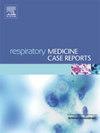Effectiveness of afatinib after long-term gefitinib treatment for EGFR L858R and S768I compound mutation-positive lung adenocarcinoma: A case report
IF 0.7
Q4 RESPIRATORY SYSTEM
引用次数: 0
Abstract
Afatinib, a second-generation epidermal growth factor receptor tyrosine kinase inhibitor (EGFR-TKI), irreversibly inhibits the pan-human epidermal growth factor receptor (HER) family. It is effective in patients with lung cancer with various EGFR mutations; however, its efficacy in overcoming resistance following first-line EGFR-TKI treatment remains unclear. Here, we report the case of a 68-year-old woman with lung adenocarcinoma (pStage IA, pT1bN0M0) who underwent surgical resection in March 2012 following several previous lung cancer resections. In November 2012, postoperative recurrence with pleural dissemination led to the detection of the EGFR L858R mutation in the malignant pleural effusion specimen using peptide nucleic acid-locked nucleic acid polymerase chain reaction clamping (PNA-LNA PCR clamp). The patient was treated with gefitinib for 8 years, after disease progression with multiple lung metastases. The metastatic lesions harbored compound EGFR S768I and EGFR L858R mutations, as identified using the Oncomine Dx Target Test Multi-CDx System (ODxTT). Treatment with afatinib resulted in rapid metastatic lesion regression. Reanalysis of the previously resected surgical specimens confirmed the presence of the EGFR S768I and L858R compound mutations in all samples, which suggests that S768I was not an acquired resistance mutation. Furthermore, immunohistochemical analysis revealed an increase in HER2 and HER3 protein expression in the gefitinib-resistant specimens. These findings suggest that HER2 and HER3 upregulation may contribute to gefitinib resistance, and that afatinib may effectively target these resistance mechanisms.
长期吉非替尼治疗EGFR L858R和S768I复合突变阳性肺腺癌后阿法替尼的疗效:1例报告
Afatinib是第二代表皮生长因子受体酪氨酸激酶抑制剂(EGFR-TKI),对泛人表皮生长因子受体(HER)家族具有不可逆抑制作用。对多种EGFR突变的肺癌患者有效;然而,它在克服一线EGFR-TKI治疗后的耐药性方面的功效尚不清楚。在这里,我们报告了一例68岁的肺腺癌(pia期,pT1bN0M0)女性患者,她在之前的几次肺癌切除术后,于2012年3月接受了手术切除。2012年11月,术后复发伴胸腔播散,采用肽核酸锁定核酸聚合酶链反应夹(PNA-LNA PCR夹)检测恶性胸腔积液标本中EGFR L858R突变。患者在疾病进展并出现多发肺转移后接受吉非替尼治疗8年。通过Oncomine Dx Target Test Multi-CDx System (ODxTT)检测,转移性病变中存在EGFR S768I和EGFR L858R复合突变。阿法替尼治疗导致转移灶迅速消退。对先前切除的手术标本的重新分析证实,所有样本中都存在EGFR S768I和L858R复合突变,这表明S768I不是获得性耐药突变。此外,免疫组织化学分析显示,在吉非替尼耐药标本中,HER2和HER3蛋白表达增加。这些发现提示HER2和HER3上调可能导致吉非替尼耐药,而阿法替尼可能有效靶向这些耐药机制。
本文章由计算机程序翻译,如有差异,请以英文原文为准。
求助全文
约1分钟内获得全文
求助全文
来源期刊

Respiratory Medicine Case Reports
RESPIRATORY SYSTEM-
CiteScore
2.10
自引率
0.00%
发文量
213
审稿时长
87 days
 求助内容:
求助内容: 应助结果提醒方式:
应助结果提醒方式:


